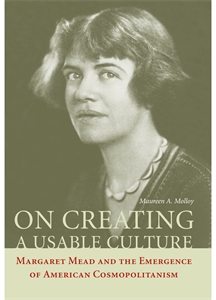On Creating a Usable Culture: Margaret Mead and the Emergence of American Cosmopolitanism
On Sale!- About the Book
-
Margaret Mead’s career took off in 1928 with the publication of Coming of Age in Samoa. Within ten years, she was the best-known academic in the United States, a role she enjoyed all of her life. In On Creating a Usable Culture, Maureen Molloy explores how Mead was influenced by, and influenced, the meanings of American culture and secured for herself a unique and enduring place in the American popular imagination. She considers this in relation to Mead’s four popular ethnographies written between the wars (Coming of Age in Samoa, Growing Up in New Guinea, The Changing Culture of an Indian Tribe, and Sex and Temperament in Three Primitive Societies) and the academic, middle-brow, and popular responses to them.
Molloy argues that Mead was heavily influenced by the debates concerning the forging of a distinctive American culture that began around 1911 with the publication of George Santayana’s “The Genteel Tradition.” The creation of a national culture would solve the problems of alienation and provincialism and establish a place for both native-born and immigrant communities. Mead drew on this vision of an “integrated culture” and used her “primitive societies” as exemplars of how cultures attained or failed to attain this ideal. Her ethnographies are really about “America,” the peoples she studied serving as the personifications of what were widely understood to be the dilemmas of American selfhood in a materialistic, individualistic society.
Two themes subtend Molloy’s analysis. The first is Mead’s articulation of the individual’s relation to his or her culture via the trope of sex. Each of her early ethnographies focuses on a “character” and his or her problems as expressed through sexuality. This thematic ties her work closely to the popularization of psychoanalysis at the time with its understanding of sex as the key to the self. The second theme involves the change in Mead’s attitude toward and definition of “culture”—from the cultural determinism in Coming of Age to culture as the enemy of the individual in Sex and Temperament. This trend parallels the consolidation and objectification of popular and professional notions about culture in the 1920s and 1930s.
On Creating a Usable Culture will be eagerly welcomed by those with an interest in American studies and history, cultural studies, and the social sciences, and most especially by readers of American intellectual history, the history of anthropology, gender studies, and studies of modernism.
- About the Author(s)
-
Maureen A. Molloy, Author
- Reviews and Endorsements
-
- On Creating a Usable Culture presents a lucid and intriguing analysis of Margaret Mead’s place in U.S. culture in the 1920s and 1930s. By focusing on Mead’s early work at this important moment in the search for the meanings of ‘American,’ Maureen Molloy reveals both the relevance of that society to the genesis of Mead’s career as a public intellectual and why Americans were so receptive to her studies of Samoa, New Guinea, and Native America. Malloy also skillfully situates Mead, the anthropologist, within the intellectual world of the ‘arbiters of American culture’ who both criticized U.S. society and hoped to redefine it.
—Julia E. Liss - This is a carefully and meticulously researched analysis of the cultural and social context in which Margaret Mead worked. Maureen Molloy’s major aim is to read Mead’s early ethnographic texts as ‘cultural artifacts’ and thus situate them within the particular cultural and social contexts from which they emerged. Using a wide variety of sources, including anthropology, cultural studies, American studies, cultural and intellectual history, and philosophy, Molloy describes the ‘place’ these works had at the time. There are many books about Margaret Mead out there, but none ask the questions asked here, and certainly none approaches the quality of this one. It is extremely sound and original.
—Nancy McDowell
- On Creating a Usable Culture presents a lucid and intriguing analysis of Margaret Mead’s place in U.S. culture in the 1920s and 1930s. By focusing on Mead’s early work at this important moment in the search for the meanings of ‘American,’ Maureen Molloy reveals both the relevance of that society to the genesis of Mead’s career as a public intellectual and why Americans were so receptive to her studies of Samoa, New Guinea, and Native America. Malloy also skillfully situates Mead, the anthropologist, within the intellectual world of the ‘arbiters of American culture’ who both criticized U.S. society and hoped to redefine it.
- Supporting Resources
-










